
views
Starting Healthy Habits

Comb instead of brushing. Hair brushes rip through tangles, leaving a lot of damage in their wake. Since dry hair is very breakable, this can leave your hair looking frizzy and rough. Instead, comb your hair while it's wet using a wide-toothed comb. This is much more forgiving and won't cause you to pull out or break your hair. If you have tangles, work them out by combing out the tangles near the tips of your hair first, then working your way up gradually to your roots. If you comb straight through from the roots, you'll break your hair. You can also use your fingers to gently work out tangles. Apply some conditioner and massage the tangles until they come out.

Let your hair air dry. Are you addicted to your hair dryer? Time to put it down and let your hair dry on its own. Directing hot air toward dry hair won't give it the chance to get healthy. While a blowout might make your hair look shiny, the heat is actually quite damaging, and over time will cause breakage and split ends. When you first start letting your hair air dry, you might not be thrilled with the results. Give it some time; after a month or so of treating your hair gently, your beautiful natural texture will finally get the chance to shine through. When you just have to style your hair with a dryer (which should be done only on special occasions), use the warm or cool setting on your dryer, and keep it several inches from your head. Be sure to use a heat protectant product, too, to minimize damage to your strands.
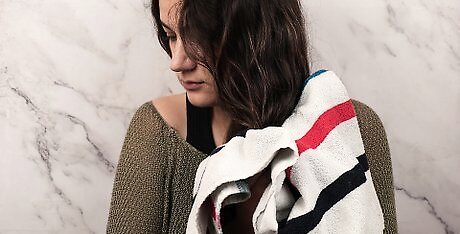
Handle your hair gently when you wash and dry it. If you have dry hair, you have fragile hair. Handling it roughly will cause your ends to split and could even lead to breakage. When you're washing, drying and otherwise handling your hair, think of it as a delicate fabric that needs to be treated with extra care. That means no scrubbing, pulling or wringing it out. When you shampoo your hair, use the tips of your fingers to gently pull the shampoo through your hair instead of roughly scrubbing it in. Rinse your shampoo using cool or lukewarm water; hot water is extra damaging to dry hair. Then, seal the cuticle with cold water as you rinse out your conditioner. When you're done, gently squeeze excess water from your hair instead of twisting and wringing it out. Pat it dry with a towel.

Shampoo less often. Hair becomes dry when the natural oils produced by your scalp aren't getting the chance to nourish it. Shampooing dry hair every day will make it even drier and more brittle since you're stripping those oils away on a daily basis. Cut back to shampooing just two to three times a week, to give your hair the chance to receive those nourishing oils. When you first cut back, you'll notice your scalp producing a lot of oil, since it's used to having to overproduce to make up for how much gets washed out. Give it a week or two and you'll find that things balance out; you'll be able to go several days in between washings without your hair looking dirty. If your roots start looking a little oily, dry shampoo is a great way to remedy the problem without washing your hair.

Halt damaging hair treatments. Straightening, curling, dyeing, or otherwise processing your hair can cause long-term damage, even if you just do it once. If your hair is dry and you're trying to restore its health, you won't see your natural shine and texture return until you give it a break from these damaging treatments. Avoid the following: Using heat styling tools like curling irons, hot rollers, or straighteners (consider options that don't require heat). Dyeing, bleaching, or highlighting (try a natural alternative).
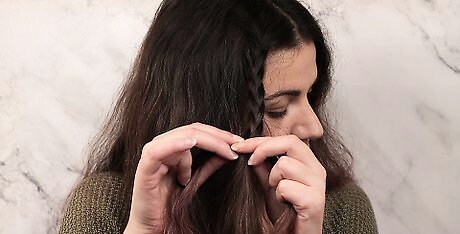
Avoid hairstyles that pull on your hair. Weaves, dreads, and other styles that involve pulling on your hair from the roots are extra damaging for dry hair. Choosing one of these styles could cause breakage or even bald spots to occur. It's best to let your hair be its natural self when you're trying to nurse it back to health.
Conditioning Dry Hair

Use a good conditioner each time you shampoo. Apply a quarter or dime-sized amount of conditioner, depending on the length of your hair. You want to use enough to coat the strands of your hair without weighing it down. Gently massage it through your hair, focusing on the tips, and rinse out with lukewarm or cool water. If your hair is extremely dry, you might want to consider a leave-in conditioner as well. This will protect your hair from drying out during the day, helping it stay shiny and manageable. These are especially great for curly hair, which is more likely to be dry. If your hair looks dull and lifeless after conditioning, you might want to switch your conditioner. Look for one made with nourishing natural oils and free of silicones.
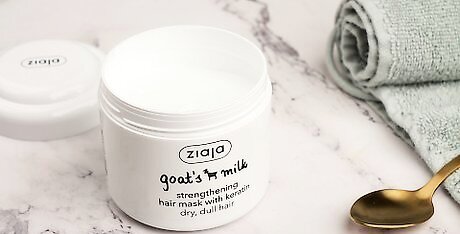
Do regular deep conditioning treatments. Restoring life to damaged hair may require more than routine conditioning. To get the shine and texture you crave, try using a deep conditioner once a week. You can use a store-bought deep conditioner or try a household oil like coconut oil, almond oil or jojoba oil. To deep condition your hair, Dampen your hair and apply one to two tablespoons of deep conditioner. Make sure it coats every strand of your hair by using a wide-toothed comb or your fingers to pull it through from roots to tips. Cover your hair with a shower cap or plastic wrap. Let it sit for at least an hour or up to overnight. Apply gentle heat with a blow dryer on a low setting if you don't have time to let the mask sit overnight. This helps the product penetrate into the hair. Shampoo your hair as normal to wash it out. It may require a second shampoo to get rid of all the remaining residue.
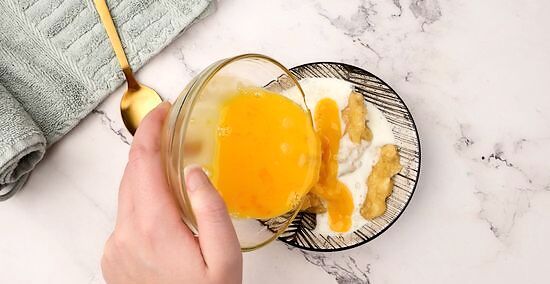
Make a homemade hair mask. If you want to instantly brighten your hair and reduce frizz, make a quick homemade hair mask you can use right before shampooing. Wet your hair in the shower and apply your mask. At the end of your shower, shampoo it out. Try the following masks: 2 tablespoons honey One mashed banana or avocado 2 tablespoons plain yogurt 1 beaten egg A combination of any of the above

Use finishing oil to protect your hair. For extra dry hair, applying a finishing oil will keep your hair from getting frizzy and puffy throughout the day. Use a dime-sized amount of finishing oil. Apply it with your fingers, focusing on the tips of your hair and avoiding the roots. Try one of these types of oil to minimize dryness: Argan oil Olive oil Coconut oil Jojoba oil
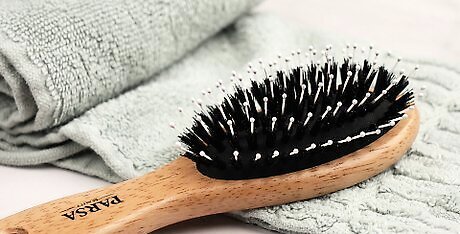
Use a boar bristle brush. While you should avoid using most types of brushes, a boar bristle brush is the one exception. This brush is made with special natural bristles that mimic the texture of your hair. It is used specifically to pull your hair's oils from the scalp all the way down to the tips, without causing any damage. It's a good investment if your hair is bone-dry and you want to pull out all the stops to rejuvenate it. Here's how to use the brush: Wait until the night before you plan to wash your hair, since that's when your roots will have plenty of oil. Comb out any tangles using a wide-toothed comb. Pull the brush through your hair from your scalp down to the tips. Repeat several times over the same section of hair before moving on. Continue until you've brushed out all of your hair. It should feel soft and silky when you're finished. Wait an hour or two before shampooing.
Growing Healthy Hair

Give yourself scalp massages. Massaging your scalp stimulates circulation near the roots of your hair, causing it to grow. Get into the habit of giving yourself a scalp massage every time you wash your hair. Using the tips of your fingers, rub your scalp in a circular motion, covering every inch of your head. As a bonus, head massages help to reduce stress and ease headaches. Try an oil massage for an extra boost. Massage coconut oil, almond oil, olive oil or jojoba oil into your scalp, then wash it out when you're finished.

Use natural hair products. Many commercially available products promise to give us healthy hair, yet they contain ingredients that do quite the opposite. Your shampoo, conditioner, and styling products may be causing your hair to be more dry and brittle than normal. Switch to all-natural products, and avoid products that have the following harmful ingredients: Sulfates: found in shampoo and other cleansers, these strip away your natural oils and leave your hair dry. Silicones: found in conditioners, these build up in your hair and cause it to look dull after a while. Alcohols: found in styling products, these contribute to dryness.

Nourish your hair from the inside out. What we eat and drink plays a major part in the appearance of our hair. If you want your hair to look beautiful, it's important to nourish your body so your hair will grow in strong and healthy. Do the following to promote healthy hair: Eat plenty of nutritious foods known to benefit the hair. Aim to get plenty of protein, omega-3 fatty acids, and iron. Choose salmon, sardines, nuts, avocados, and flaxseeds. Drink plenty of water to stay hydrated. This prevents your hair from drying out. Avoid smoking. The smoke from cigarettes can end up damaging your hair.

Protect your hair from sun and other elements. Spending lots of time in the sun without protection can fry your hair. It's important to protect your hair, just as you would your skin, by covering it up when you know you'll be in direct sunlight for hours at a time. Wear a sun hat to keep your hair shaded if you'll be in the sun all day. In the pool, protect your hair from chemicals by wearing a swim cap. In very cold weather, protect your hair from cold, dry air by wearing a warm hat.

Get regular trims. Following all these steps will cause new, healthy hair to start growing in. Get your hair trimmed every two to three months or so to get rid of the dry, damaged ends that are growing out. After several months, your old, damaged hair will be replaced by beautiful new growth.




















Comments
0 comment